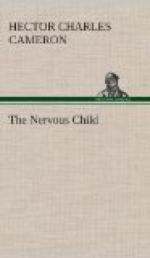The ill-effects of departing too readily from ordinary nursery routine on account of a little illness, and of adopting straightway a variety of measures of treatment, is well shown in cases of asthma in children. The asthmatic child is almost always of a highly nervous temperament, and often passionate and ungovernable. Often the most effective treatment of an attack, which usually comes on some hours after going to bed, is to make little of it, to talk naturally and calmly to the child, to turn on the light, and to allow him, if he will, to busy himself with toys or books. To be seized with panic, to send post-haste for the doctor, to carry the patient to the open window, to burn strong-smelling vapours, and so forth, not only is apt to prolong the nervous spasm on this occasion, but makes it likely that a strong impression will be left in his mind which by auto-suggestion will provoke another attack shortly. With nervous children a seeming neglect is the best treatment of all trivial disorders. Meanwhile we can redouble our efforts to remedy defects in management, and to obtain an environment which will gradually lower the heightened nervous irritability.
When the illness is of a more serious nature, as has been said, the restlessness as a rule promptly disappears. In each case it must be decided whether it is best for the child to be nursed by his mother and his own nurse, or by a sick-nurse. In the latter event the ordinary nurse and the mother should absent themselves from the sick-room as much as possible. Often the firm routine of the hospital nurse is all that is wanted to obtain rest. Less often, the child will be quiet with his own nurse, and quite unmanageable with a stranger.




